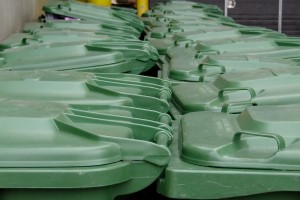Confessions of a bad recycler
Many municipalities in Canada have green bin waste programs where residents set organic waste aside for composting.
Ok, so I admit it; although I claim to be into green living… I’m a terrible (gasp!) recycler. It started with my blue bin. I live in a house that is actually three apartments. You wouldn’t say so if you looked at it from the street, so it’s understandable that the collected detritus of five residents make me look like a complete wino.
Since I’m responsible for the garbage, I’ve just had to make peace with the tsk tsking of the garbage man. But that’s not really the biggest issue for me. For me, it’s the green bin. Oh cursed, smelly green bin from hell.
At first I tried composting at home, but the raccoons just kept raiding my compost bin. I swear if properly trained, those critters could crack Fort Knox in a single afternoon. Also, I don’t have a very big garden and most of my veggies and plants are in containers, making the giant pile of compost our home would produce somewhat moot. So to the green bin….
Smelly green bin, smelly green bin… what are they feeding you?
It was ok in the winter, but now in the summer, the walk to the bin is daunting indeed. I try not to breathe in, but the smell always manages to get me. Not to mention the fruit flies! Sure I clean it regularly, but the volume of veggies and the heat in the city render it smelly well before week’s end.
Full disclosure; I don’t always peel off those PLU stickers of my veggie waste and the collection of rubber bands under my sink threatens to overwhelm, so I may occasionally leave those on too. It’s not like they’re the only plastic bits that go into the green bin. Most people use plastic bags to collect their green waste and these go in the green bin along with diapers, female sanitary products, meat and pet poo.
The program in Toronto was beset with difficulties initially as a Toronto Star investigation led to accusations that green garbage was rerouted in some transit stations and ended up in landfills simply because there was too much of it to be processed by the fledgling program. These allegations were strongly denied at the time, and seem to have been rectified as the program matured.
What happens to your green garbage?
Green garbage is transported to municipal facilities where an aerobic composting system is used to transform green bin material into compost over a period of approximately seven months. During the process, the waste is chopped up and water is added so that plastic can float to the top and be removed.
The resulting compost is available to the public for use in agriculture and other applications. Many organic farmers opt out of using green bin garbage; “We just can’t be sure what’s in it,” says Ran Goel of Fresh City Farms in Toronto, “since there is no way to control what people put into the bins, and the sorting process isn’t effective; we can’t take the risk.”
Despite the inherent problems with the organic waste program, it does keep a large portion of waste from the landfills. Our organic waste is a valuable resource for our communities. So we have to tweak a few things here and there, fair enough. But the green bin program is a step in the right direction. The transportation of garbage (often to the US for processing) means that it has a huge carbon footprint, and we need to lobby for more effective local processing.
What can you do?
- We need to put pressure on our municipalities to process as much of the organic waste locally as possible.
- More effective sorting and testing criteria will help to keep the compost safe.
- We need to stop putting non-organics in our green bins. Instead of plastic bags to line the bin, use newspaper or biodegradable trash bags.
Need some good karma? Like us on Facebook and get more good vibes than you can poke a sharp stick at!




